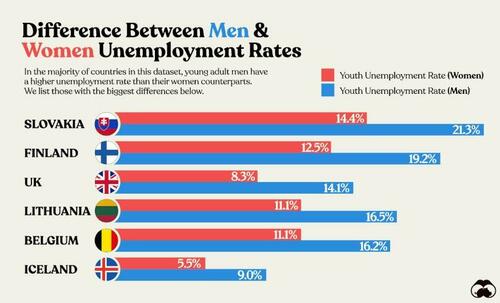by Paul Joseph Watson, Summit News:

In nearly every country in the world, youth unemployment is much higher than general unemployment.
Unfortunately, the pandemic only exacerbated matters. During a crucial stretch of their early careers, young adults were locked out of entry-level jobs, destroying their ability to pick up work experience and potentially impacting their long-term earnings.
TRUTH LIVES on at https://sgtreport.tv/
Now, nearly three years after COVID-19 first hit, young adults from some countries, like China, are struggling to find jobs. Using data from the OECD and the National Bureau of Statistics of China, Visual Capitalist’s Pallavi Rao and Niccolo Conte chart out the youth unemployment rate for 37 countries.

Ranked: Countries With the Highest Youth Unemployment
At the top of the list, Spain has the highest youth unemployment in the OECD, with nearly one in three young adults unable to find a job.
ℹ️ Unemployed people are those who report that they are without work, are available for work, and have taken active steps to find work in the last four weeks. The youth unemployment rate is calculated as a percentage of the youth labor force.
A mismatch between educational qualifications and the labor market has been cited as a significant reason for Spain’s lack of employed adults between the ages of 15–24.
Meanwhile, the country’s reliance on temporary contracts and dependence on seasonal sectors—like tourism—to generate jobs are some of the many reasons for its persistently high reported unemployment across demographic groups.
Listed below is the youth unemployment rate for all the OECD countries, and China, as of the second quarter of 2023.
| Rank | Country | Average Youth Unemployment Rate |
|---|---|---|
| 1 | 🇪🇸 Spain | 27.4% |
| 2 | 🇨🇷 Costa Rica | 27.1% |
| 3 | 🇸🇪 Sweden | 24.9% |
| 4 | 🇬🇷 Greece | 23.6% |
| 5 | 🇨🇳 China | 21.3% |
| 6 | 🇮🇹 Italy | 21.3% |
| 7 | 🇨🇱 Chile | 19.8% |
| 8 | 🇱🇺 Luxembourg | 19.6% |
| 9 | 🇸🇰 Slovakia | 18.8% |
| 10 | 🇨🇴 Colombia | 18.7% |
| 11 | 🇵🇹 Portugal | 17.2% |
| 12 | 🇹🇷 Türkiye | 17.0% |
| 13 | 🇫🇷 France | 16.9% |
| 14 | 🇫🇮 Finland | 15.8% |
| 15 | 🇪🇪 Estonia | 15.6% |
| 16 | 🇧🇪 Belgium | 13.9% |
| 17 | 🇱🇹 Lithuania | 13.8% |
| 18 | 🇨🇿 Czech Republic | 13.7% |
| 19 | 🇭🇺 Hungary | 13.3% |
| 20 | 🇬🇧 United Kingdom | 11.4% |
| 21 | 🇱🇻 Latvia | 11.0% |
| 22 | 🇵🇱 Poland | 10.3% |
| 23 | 🇳🇴 Norway | 10.2% |
| 24 | 🇨🇦 Canada | 10.2% |
| 25 | 🇦🇹 Austria | 9.6% |
| 26 | 🇩🇰 Denmark | 9.3% |
| 27 | 🇳🇱 Netherlands | 8.3% |
| 28 | 🇺🇸 United States | 8.0% |
| 29 | 🇦🇺 Australia | 7.8% |
| 30 | 🇮🇪 Ireland | 7.4% |
| 31 | 🇮🇸 Iceland | 7.3% |
| 32 | 🇩🇪 Germany | 6.1% |
| 33 | 🇸🇮 Slovenia | 5.6% |
| 34 | 🇰🇷 Korea | 5.4% |
| 35 | 🇮🇱 Israel | 5.3% |
| 36 | 🇲🇽 Mexico | 5.2% |
| 37 | 🇯🇵 Japan | 4.2% |
Announced in June, China’s youth unemployment rate has climbed to 21.3%, a meteoric rise since May 2018, when it was below 10%. The Chinese economy is in the midst of a slowdown and its steadily climbing youth unemployment prompted the government to suspend age-specific unemployment data for the near future.
On the other side of the spectrum, in Japan, only 4.2% of young adults are without a job. A key reason for this is Japan’s shrinking and aging population that’s made for a tight labor market.
Youth Unemployment: Men vs Women
In most OECD countries, it’s common to see young men experiencing a higher unemployment rate compared to young women.
This contrasts with the trend across all age groups in the OECD, where the unemployment rate is 6.3% for women and 6% for men.
We visualize the countries in the dataset with the biggest gaps in youth unemployment below.

There is no singular reason that explains this common gap.
Across the OECD, more young women opt for tertiary education than young men, which may lead to better employment prospects. At the same time women are overrepresented in the health and social welfare sectors—both growing rapidly thanks to an aging population—that may make it easier for them to find jobs.



